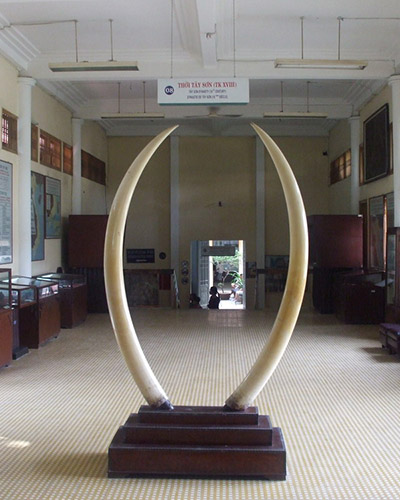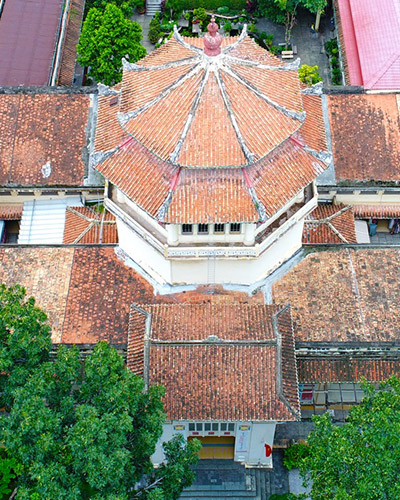Vietnam History Museum
1929, History Museum in Ho Chi Minh City is a large museum and has a long history of development in South
Vietnam. Located in the heart of the city, the Museum is a popular destination for both domestic and
international visitors.
.jpg)
.jpg)
History
History Museum in Ho Chi Minh City was formerly the Museum of Blanchard de la Brosse (a name of governor in
the South of Vietnam) founded in 1929 and the first museum in South Vietnam
From 1956, the museum was named "Vietnam National Museum" in Saigon, which showcases ancient art in some
Asian countries.
Since August 23, 1979, the museum has been officially renamed under Decision No. 235/QD-UB by the People's
Committee of Ho Chi Minh City.
.jpg)
In 2012, the Museum building was recognized as National Artistic Architecture Monument. An orient-specific
architecture combined with the West architecture creates a building structure that is firm, harmonious and
balanced with the surrounding landscape.
Now, Currently, the museum has owned more than 40,000 items on display with many unique and valuable
collections originating from many countries and ethnic groups; extremely diverse, abundant materials and
types. Collections introduce Vietnamese history and culture from the primitive era to 1945 and introduce
unique cultural features in the Southern provinces and some countries in Asia.
The museum is also home to many experts and researchers on history, culture, society in Vietnam, cultures in
the region and the world with qualified and experienced staff.
.jpg)
In the current development trend, in order to meet the needs of enjoying cultural values in the spiritual
life of the public, the Museum must always renew its activities with the aim of promoting the Museum for the
sake of community.
On the precinct of 6.057m2, Ho Chi Minh City History Museum is an architectural complex including two
buildings: The front building was built in 1927 and the rear building was built in 1970.
The front Building was formerly Blanchard de la Brosse Museum, designed by architect named Auguste Delaval
with ancient architectural feature. This Building has a length of 70m, width of 30m, its total area used is
2,100m. The overall plan consists of the octagonal tower block in the center as a highlight and also
symmetric axis for two rows of the Building on two sides. In general, the architecture of this Building is
in typical Indochinese style.
.jpg)
The following Building was designed by architect named Nguyen Ba Lang, built in series to the front
Building. The Building is U-shaped with an area of 1,000m2, designed in harmonious way and process the
landscape to match the ancient architecture of the rear building.
Although decorative motifs used in the museum architecture are made of various materials (wood, iron,
cement), they are common patterns and similar to many contemporary ancient architectural works. Each detail
has different meanings but in general, they have a good meaning. This is the intangible cultural heritage
that is contained in the Building, in particular decorative architectural motifs. These motifs also show the
cultural exchange of Vietnam - France, making the museum architectural work have not only Asian but also
Western features.
.jpg)
In general, the architecture of the Building has designs in line with the function of a museum such as: High
foundation, thick walls for anti-moisture and good load bearing; high ceiling with windows close to the roof
to take advantage of the natural light for the rooms, etc. It can be said that the building of History
Museum – Ho Chi Minh City has been used in accordance with original design function so far. Until 2012, the
Building of History Museum – Ho Chi Minh City was ranked by the Ministry of Culture, Sports and Tourism to
be as a national architectural monument.
The following Building was designed by architect named Nguyen Ba Lang, built in series to the front
Building. The Building is U-shaped with an area of 1,000m2, designed in harmonious way and process the
landscape to match the ancient architecture of the rear building.
.jpg)
Although decorative motifs used in the museum architecture are made of various materials (wood, iron,
cement), they are common patterns and similar to many contemporary ancient architectural works. Each detail
has different meanings but in general, they have a good meaning. This is the intangible cultural heritage
that is contained in the Building, in particular decorative architectural motifs. These motifs also show the
cultural exchange of Vietnam - France, making the museum architectural work have not only Asian but also
Western features.
In general, the architecture of the Building has designs in line with the function of a museum such as: High
foundation, thick walls for anti-moisture and good load bearing; high ceiling with windows close to the roof
to take advantage of the natural light for the rooms, etc. It can be said that the building of History
Museum – Ho Chi Minh City has been used in accordance with original design function so far. Until 2012, the
Building of History Museum – Ho Chi Minh City was ranked by the Ministry of Culture, Sports and Tourism to
be as a national architectural monument.
.jpg)
.jpg)
.jpg)
.jpg)
.jpg)
.jpg)
.jpg)







